Glass Act: Big or Small, Nancy Keating’s mosaic art catches the eye
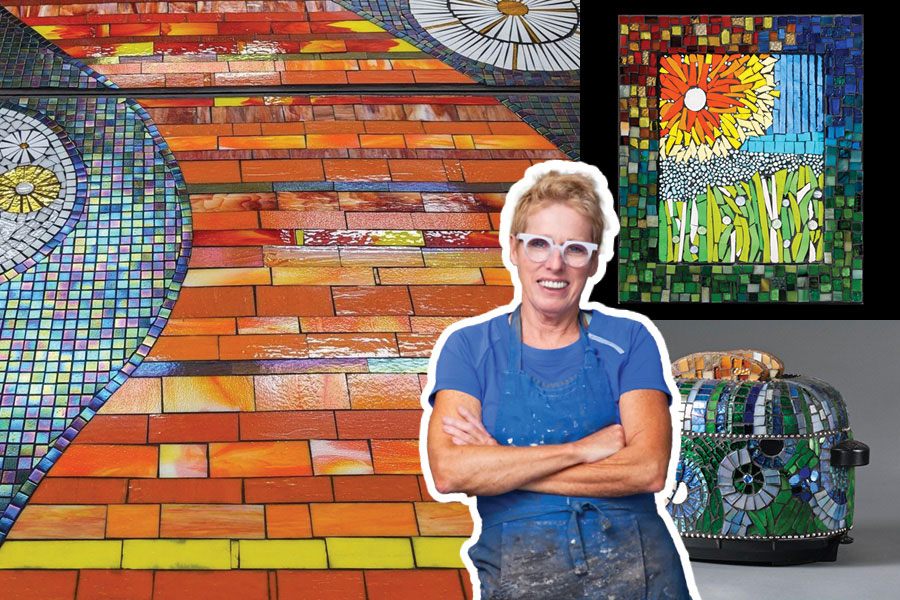
For contemporary mosaic artist Nancy (Havens) Keating, BA’72, no canvas is too large, too small, or too cumbersome. Working with vibrantly colored glass for the past 30 years, Keating has embellished everything from 40-foot-high walls to vintage toasters and teapots.
The artist, who majored in French at IU, didn’t really have a career plan during college; it was the late 1960s and she enjoyed learning for the sake of learning and broadening her intellectual outlook.
Keating briefly taught high school French and later had a career in visual merchandising before finding her true love—mosaic art.
After taking some intensive courses at the Institute of Mosaic Art in Oakland, Calif., she discovered Kokomo (Ind.) Opalescent Glass—the country’s oldest art glass manufacturer—and Keating was on her way.
For small works, she finds inspiration in some unexpected places—such as chrome and Bakelite toasters from the 1930s, ’40s, and ’50s.
She transforms the defunct appliances by first removing their frayed, fabric electrical cords and then carefully de-crumbing and clear coating their interiors (which often used to be coated with asbestos).
Next, Keating uses a glass scorer and running pliers to cut and detach precise glass shapes that she adheres to the toasters. She also creates slices of ceramic “toast” that she fires in a friend’s kiln and subsequently also mosaics. She finishes her works with custom-tinted grout.
After mapping out a design, Keating also follows a similar process for large-scale installations like Cosmic Flow, which stretches 40 feet up on two sides of the Civic Square parking garage in Carmel, Ind. Piece by piece, she constructed Cosmic Flow in multiple 65- to 110-pound sections in her studio. Then, she hired a construction crew to attach the structure onto the building using a cherry picker.
The following interview with Nancy Keating was conducted in early summer 2024. See more images of her mosaic art.
I originally came across your work on the Indiana Artisan website. How long have you been an Indiana Artisan?
Nancy Keating: I’ve been an Indiana Artisan for at least 10 years—maybe 12 years. I’m very proud of that. It’s a kind of a big stamp of approval.
I then went to your website and looked at the rest of your work and did not realize that you do such large, mural-type installations, too. What materials are those made from?
NK: I’m a glass mosaic artist. I don’t work in ceramic. I work in glass.
So even the really large installations are glass?
NK: You bet. The last one I did was 450 square feet.
Wow. And you’re cutting those by hand?
NK: Yes, I am. The last one I did was a year from concept to installation.
And where was that one installed?
NK: That was installed on two sides of a building in Carmel within an area they call Civic Square outside of their main parking garage.
How do you even install something like that?
NK: It was quite an undertaking. I’m an artist. I’m not a structural engineer, right? So, I did have to employ some structural engineers to kind of guide me for [the] installation.
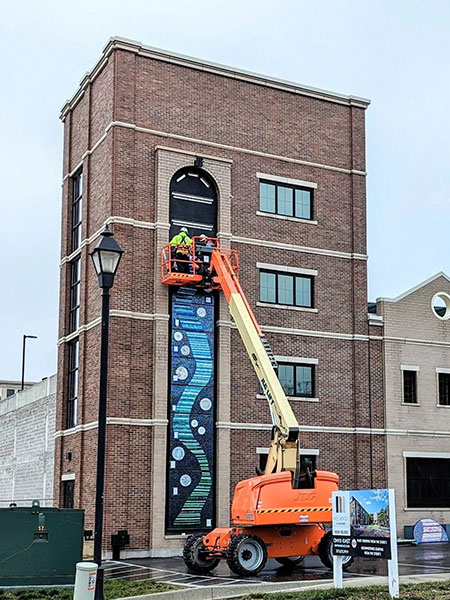
Cosmic Flow, which stretches 40 feet up on two sides of the Civic Square parking garage in Carmel, Ind., was constructed piece by piece, in multiple sections in Keating’s studio—and took nine months to complete. A construction crew was hired to attach the structure onto the building using a cherry picker.
I know you have an IU background. Could you tell me a little about that?
NK: I do! I graduated in 1972.
And your professional title is mosaic artist?
NK: That’s right. I am a mosaic artist—I am a contemporary mosaic artist. I like to say that. ‘Contemporary’ means two things to me. It’s my style and it’s also the technique that I use. It’s contemporary.
How long have you been creating these mosaic pieces?
NK: Well, I’ve been a glass mosaic artist for probably 30 years now.
And how did you get started?
NK: Oh my gosh. Well, when I started working in mosaics, it was not a very popular art style at all. Luckily, it has become really popular now. So, when I began, I decided I wanted to work in glass. There was no YouTube. There were no books. There was nothing to guide you, so there was a lot of experimentation. And then I discovered the Institute of Mosaic Art in Oakland, Calif. I had some friends that live out in the Bay Area, and I would fly out there and take two- and three-week intensive courses. That really catapulted my craftsmanship and my artistry.
That sounds like a very obscure program. Was it?
NK: I teach a lot now, and there are other mosaic artists across the country who are very, very talented and skilled who also teach. But, in 1994, there was nowhere to learn mosaics unless you wanted to go, maybe, to Italy.
OK. So, you graduated from IU Bloomington in 1972. I recall that your degree was in a language.
NK: My degree is in French.
You majored in French. Did you have a minor?
NK: Spanish!
And, at that point, did you have any thought as to what you wanted to do for a profession?
NK: That was a long time ago. You know, we went to college back then—we went to university for the sake of learning. It was a different era. It was kind of frowned upon that you wanted to make money from it. You wanted to get a degree for the sake of learning and broadening your intellect.
Now it’s all about going to school to learn a profession and make money. In 1968, that wasn’t the mindset. Languages came easily to me. I enjoyed it. I enjoyed all of my courses and my professors. What I was going to do with it, I had no idea. I ended up teaching high school French for one year and found out that was not for me.
So, did you do any other kinds of art before you started to gravitate to mosaics?
NK: Yeah, well, I sort of did. I had a career in visual merchandising. I worked for a fragrance company and did a lot of visual merchandising with them. I was a visual merchandiser for a department store, so that was sort of artsy, I guess.
But I just got lucky. I found an art medium that fascinated me, and I thought, ‘Why not try it?’ So, starting out, it was trial and error—lots more error than success.
Do you remember the first thing you ever made?
NK: Well, my company name is called ‘Mosaics Garden,’ which is sort of misleading. When I started out, I was doing garden art which sold really well. I am, at heart, a businesswoman and also an artist. So, I made a birdbath and garden benches and steppingstones and did the juried art fair circuit and made a nice living doing that, but then my work kind of morphed when I started going to the Institute of Mosaic Art in San Francisco. And what I like to say is that I discovered Kokomo Opalescent Glass. It’s eye candy! It’s our Indiana treasure!
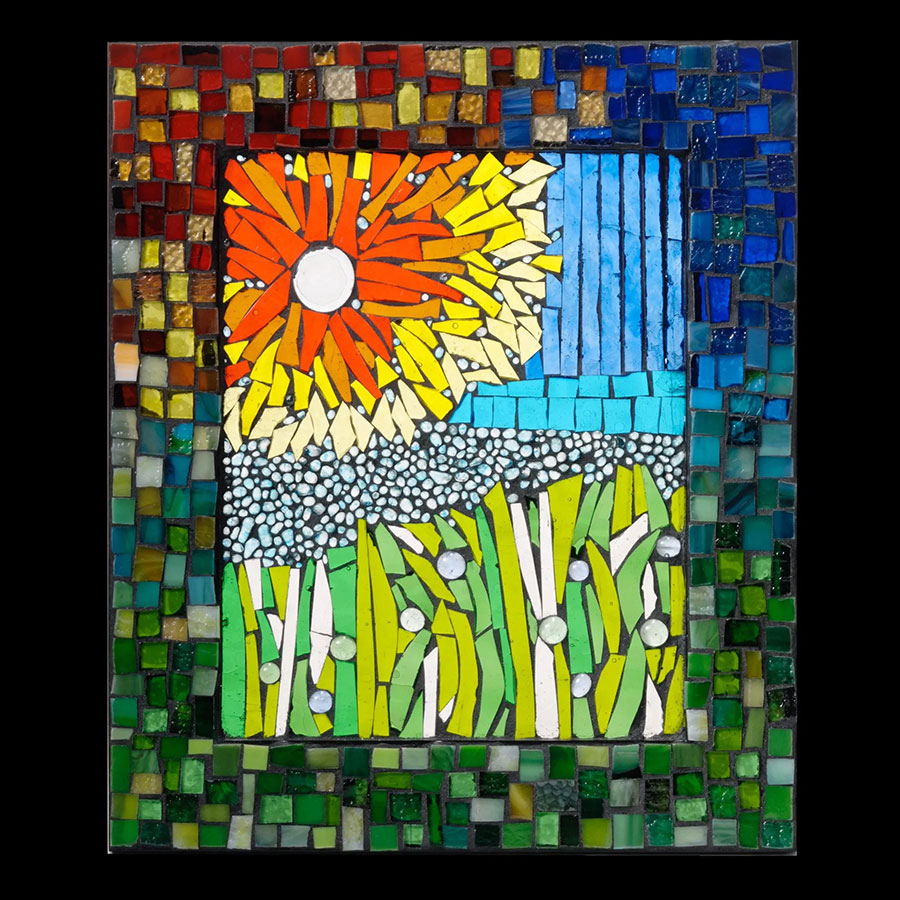
Oh! I want to hear more about this…
NK: Kokomo Opalescent Glass—they have been producing art glass since the 1880s. They made all of the art glass for Tiffany’s creations. They have shipped glass all over the world for ecumenical installations and they’re still producing glass in Kokomo, Ind., the same way they’ve done for over 100 years.
I discovered Kokomo glass and said, ‘That’s it. That’s my medium. There we go.’ I always say that beautiful materials create a beautiful mosaic. So, I’m in love with glass. I am addicted to it. I can’t have enough.
At what point did you go from three-dimensional works to these big installations?
NK: I do it all. I love doing it all. Plus, I make a living doing this. I welcome big commissions like that. They’re a large chunk of my income.
Have they all been in Indiana …?
NK: I did some large murals in California, but that was collaborating with other artists. But my own murals are actually all in Indianapolis and Carmel.
Where would people be able to find some of these?
NK: Along the Monon Trail in Carmel. In Civic Square in Carmel. A place called Sophia Square Courtyard in Carmel has some of my work. I just finished a beautiful installation interior at a new independent bookseller in Indianapolis.
So, regarding the subject matter, are these installations abstract or realistic?
NK: I don’t do representational work. That’s not my forte. I do more abstract work. I’m more about color, pattern, and reflectivity. The large mosaics on the outside of the Civic Square parking garage are 40 feet tall and they are entitled Cosmic Flow. And, if you see pictures of it, the orientation is tall and narrow, and it flows up to the sky and the colors change.
I did a large butterfly along the Monon Trail, and I’ve been commissioned by Carmel to do a series of smaller glass butterflies.
I’m looking at a photo of one of your large installations and I don’t even know how you would go about…
NK: Those were constructed totally in my studio in sections, and then I ran out of room, so I leased some storage space. I would store the sections, and then they were pieced together for the installation.
So you had it all kind of mapped out and then you would do the cutting, and you would have it arranged. And then, after it was all completed in these sections, you had somebody help you put it up?
NK: If you look on my website, there’s an amazing video about the mural install. There’s a link to video on YouTube about the install.
I’ll check that out. I see some photos of somebody in a cherry picker here…
NK: Those are the people I hired to put it up.
So, were you in the cherry picker with them?
NK: I’m not going up that cherry picker! [laughs]
Yeah, I wouldn’t want to either! What kind of adhesive or how did they get them to stick on the wall?
NK: The mural was constructed on panels in my studio—completely 100% done. Then, structural engineers came up with these wonderful systems with a backing that clicks onto a structure on the building. They get credit for that engineering. It was brilliant.
How much do you think these individual panels weighed?
NK: The smaller panels were 65 pounds and the bigger ones—110 pounds each.
That’s remarkable. So, your most recent project was the inside of the new bookstore, right? And I’m curious to know, too, do you have a dream project for the future? Some dream piece that you want to work on.
NK: The new bookstore. Right.
I would love to do something three dimensional on the Monon Trail. I would love to do a mosaic couch [that] people can sit on. But the city pays me to do these things. I’d have to pitch it to them and have them agree. Then the City Council has to approve it.
About your creative process—we’ll move on from the big installations for the time being and talk about the smaller things. Could you maybe describe one of your toasters for me? How do you mosaic one of those? How do you do that from beginning to end?
NK: Well, first of all, I had to find a vintage toaster. The toasters from the ’30s, ’40s, and ’50s are so much more interesting than what they’re making now. They had these beautiful Bakelite handles. They were also made out of chrome. Those toasters were gorgeous. The ones that are made nowadays are mostly plastic, and you can’t mosaic those.
So, these vintage toasters don’t work anymore. I mean, they were old, with the old fabric cords. So, you know, I just figured they were destined for the landfill. So, I cut off the cord. Then, you have to clean out the inside. You get all the old crumbs out and everything. It’s amazing. Those old toasters—they used to be coated with asbestos, which you don’t want to disturb, so I [seal it with] several clear coats.
And then, a lot of times the form of the mosaic kind of talks to me to tell me what to do.
One of the toasters I did was a 1960s toaster. I was thinking of like The Brady Bunch and kind of a ‘flower power’ kind of design. That’s what happened there.
Some of the other toasters were—the design was lyrical to me. There were little vines on the Bakelite handles. So, the design on the toaster turned out to be kind of vines and circles. Kind of a more lyrical theme. The toaster kind of talks to me, and it’s all glass. I cut the glass—it’s not broken glass ever. It’s cut precisely with running pliers and a scorer into little pieces adhered onto the toaster.
Then, I have a friend who has a kiln. And, so, I create the toast out of ceramic and then put glass on that. It’s mosaic toast!
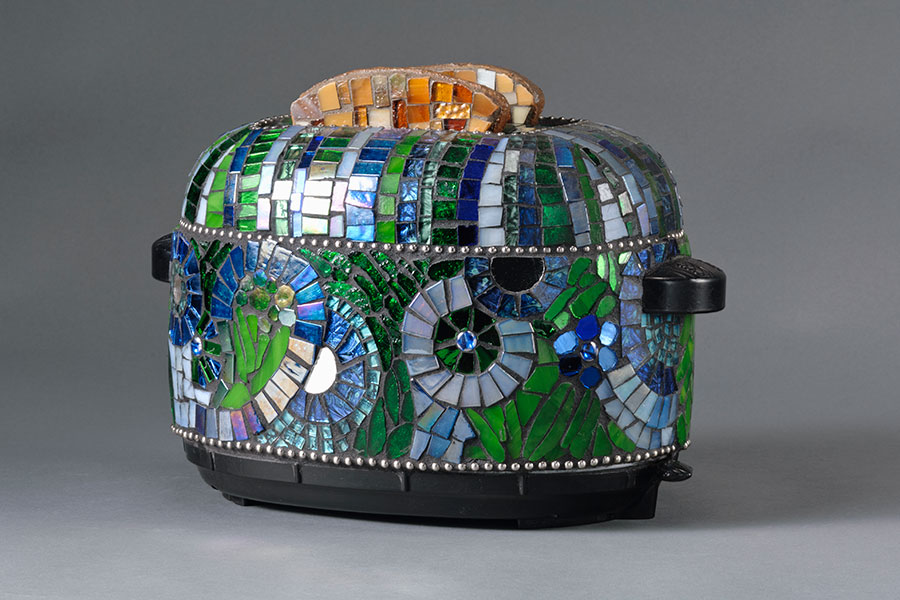
Keating has created countless mosaic works of art, from wall hangings and everyday household objects, like this toaster, to public works of art, community mosaics, and architectural installations. Photo: Nancy Keating.
What a neat thing. I can just imagine that conversation. ‘Hey, I’d like to make some toast. Can I use your kiln?’ Do you want to talk briefly about your teaching?
NK: Oh, I love to teach. I teach in my private studio, and—especially since so many [people] come in and they’re so excited—but they say to me, ‘Oh, I just don’t know if I can do this’ and ‘Oh, well, I’m not creative,’ which is baloney! It’s my job to kind of funnel their creativity. And after five days or a four-day session, they are so excited and just beaming and so happy with what they’ve created. It’s a real rush to me. It’s amazingly joyful.
How long do these classes last? Are they over a period of weeks or one session or …?
NK: They’re, like, three or four sessions back-to-back. Because it’s not a form of art you can do quickly. There’s a lot of patience required.
So, you’re gluing these things and then, at the end, do you go back over it with some sort of grout material?
NK: That is my style. Not all mosaic artists work that way. Some mosaic artists set [objects] in a bed of mortar, but I do use grout and I custom tint my grout, so it becomes part of my design.
Will you be making any more toasters—if you found the right toaster? Or are you all toaster-ed out?
NK: I do have some toasters backed up, but probably not. I am pretty booked… with a couple of teaching workshops and then my big commission from the city of Carmel to do the series of butterflies.
Your series of butterflies—could you say more about those?
NK: Let’s see. If you go to my website, there’s a link to the big butterfly. It says, ‘My big butterfly selfie mural is up.’ It’s seven feet wide and it was designed to be a selfie station.
And it was for tourism for the city of Carmel. One side of the butterfly—one wing in glass says ‘Carmel’ and the other side of the wing in glass says ‘Indiana.’ So, it was their idea that they wanted it to be a selfie station to promote tourism and Carmel.
What a fun idea! Thank you so much!
NK: Well, thank you!
Mosaic Shortcuts
Nancy Keating utilizes some surprising everyday objects in her mosaic-making process. Learn more about these, and other, household items she uses to create her mosaic artworks.
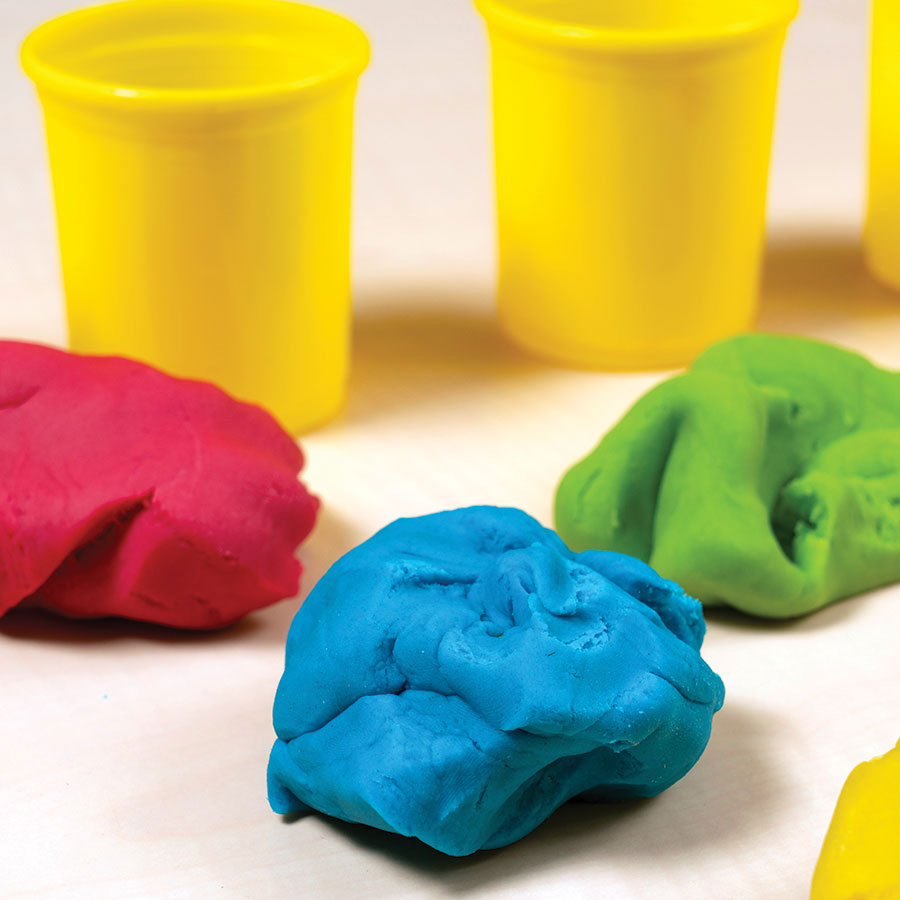
Play-Doh
This children’s modeling clay can be used to mask off parts of a mosaic when using different grout colors.
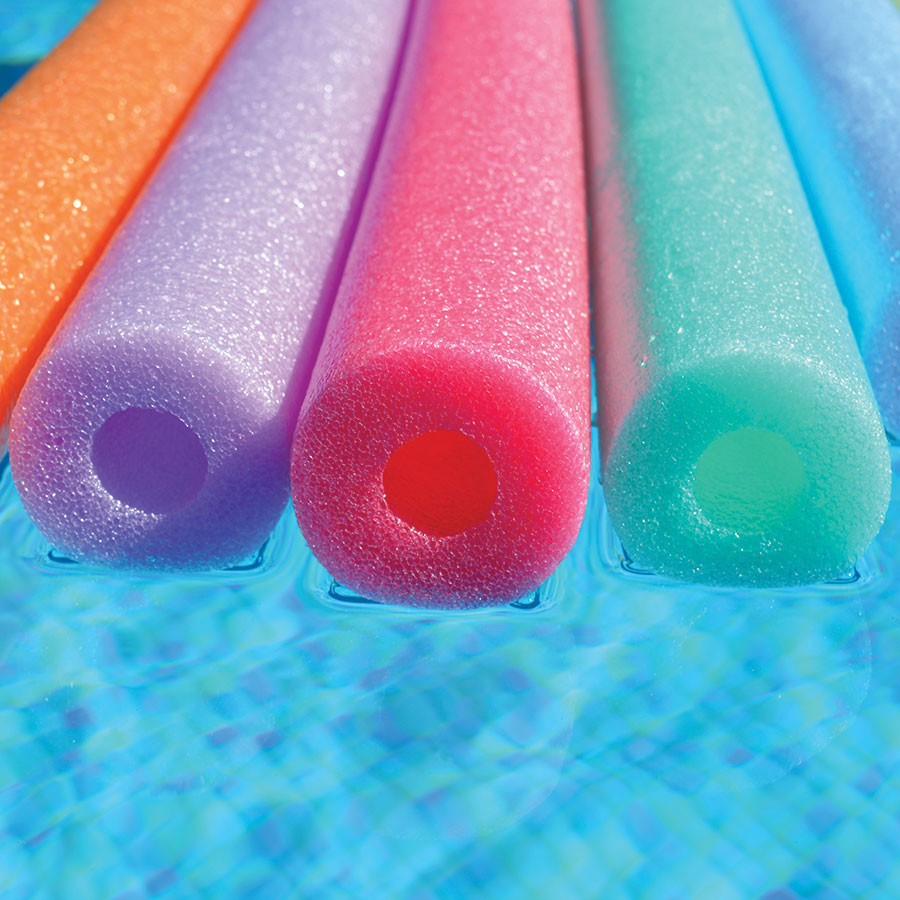
Pool Noodles
A slice of pool noodle is perfect for spreading grout and protects fingers from any sharp cut glass.
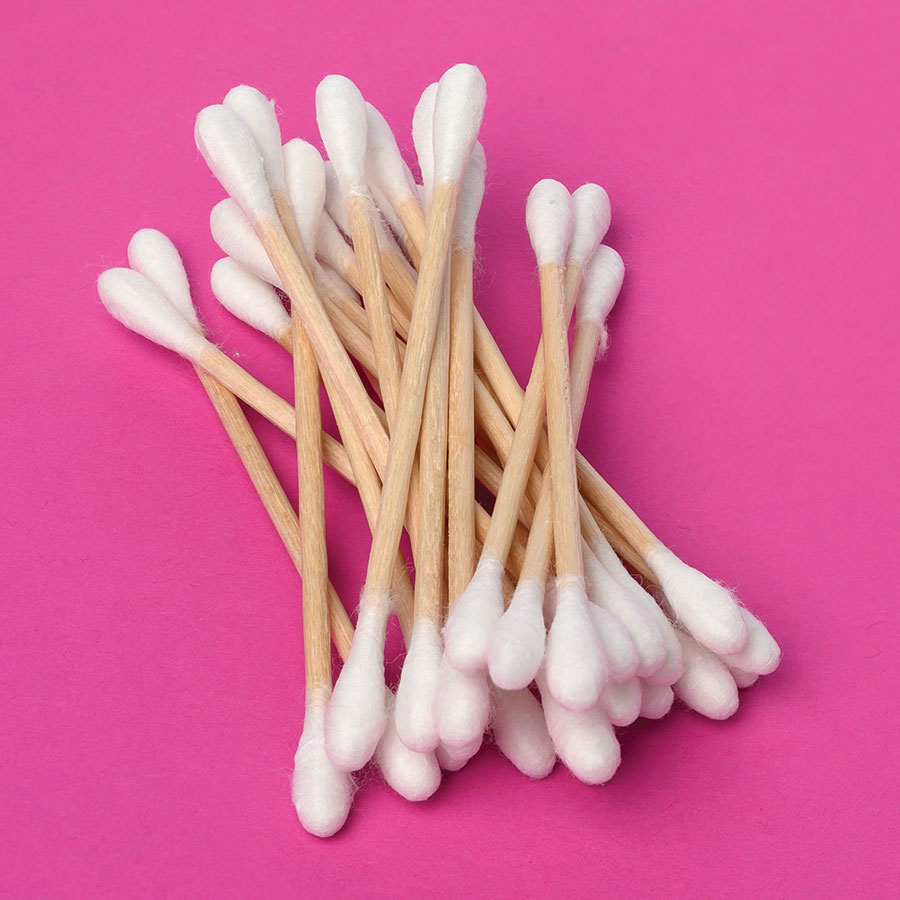
Cotton Swabs
Cotton swabs help spread out too much adhesive and shove grout into those hard to reach places.
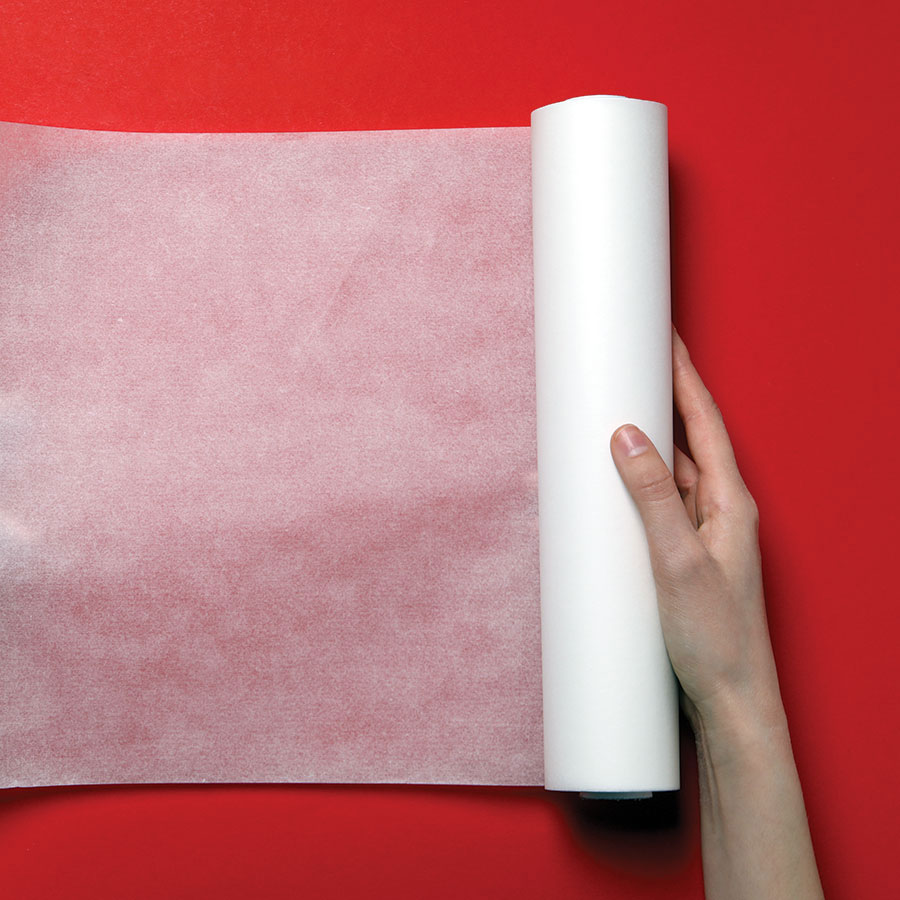
Freezer Paper
As a mesh underlayer, it’s easier than plastic wrap. Adhesive will not stick to its slippery smooth side.
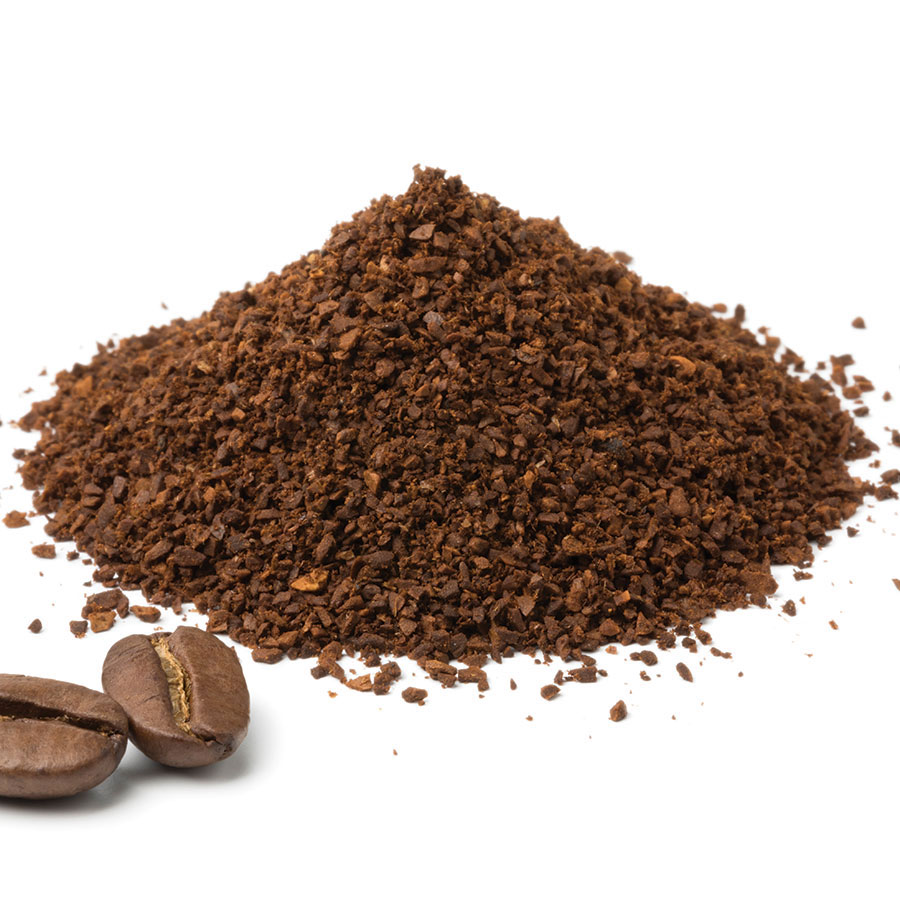
Coffee or Tea
Adding a little coffee or tea into mortar or grout mix creates a nice tan-or ivory-colored grout.
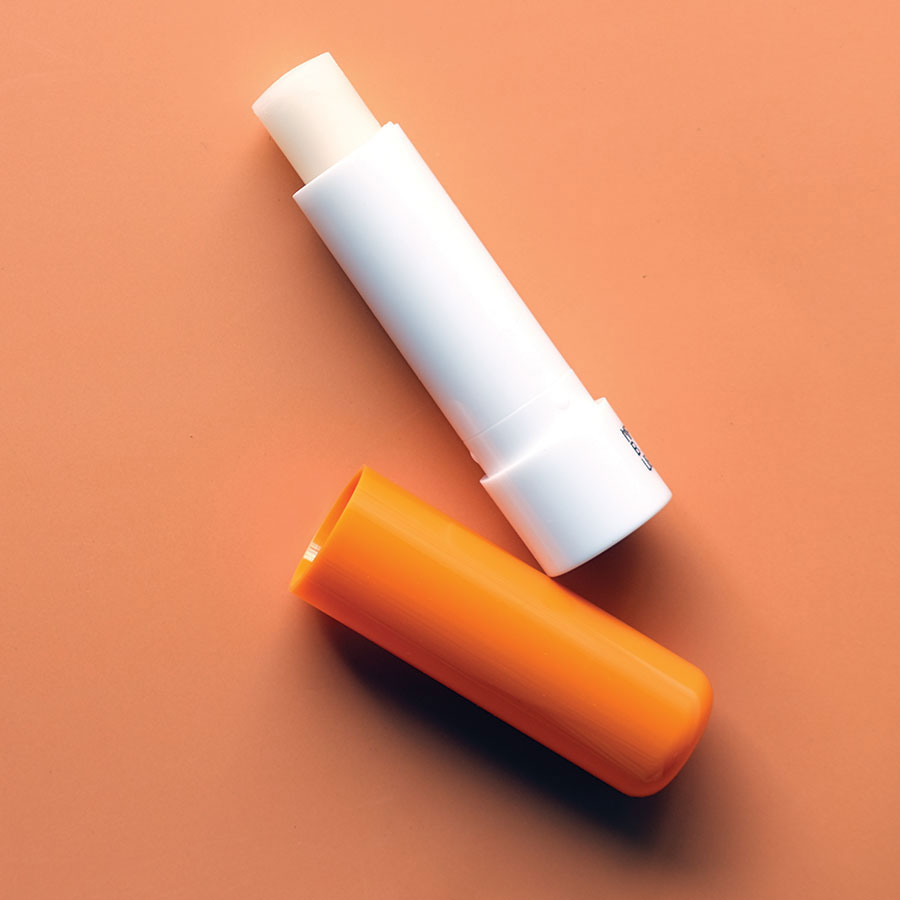
ChapStick
Coating glass or tile marker guide lines with ChapStick helps keep guide lines from disappearing when using a wet saw.
Written By
Susan M. Brackney
Susan M. Brackney, BA’94, has been a professional writer since 1995. A member of the American Society of Journalists and Authors, she has written four nonfiction books, including Plan Bee: Everything You Ever Wanted to Know About the Hardest-Working Creatures on the Planet.